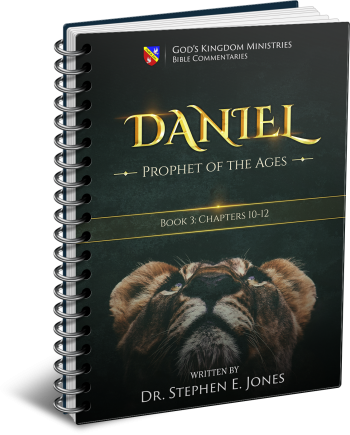Latest Posts
View the latest posts in an easy-to-read list format, with filtering options.

This is a commentary covering the last three of Daniel's visions in chapters 10-12.
Category - Bible Commentaries

Daniel 12:7 says,
7 And I heard the man dressed in linen, who was above the waters of the river, as he raised his right hand and his left toward heaven, and swore by Him who lives forever that it would be for a time, times, and half a time; and as soon as they finish shattering the power of the holy people, all these events will be completed.
An earlier revelation (Dan. 7:25) mentioned an identical time frame. As we showed earlier, it is 3½ “times,” or 1,260 years. Each “time” is 360 years in long-term prophecy.
In Dan. 7:25, this 1,260-year period is attributed to the “little horn,” which was the extension of the fourth beast (Rome). However, in Dan. 12:7 the same time frame is applied to the third beast (Greece). There are, then, at least two cycles of 1,260 years to consider.
Recall that the overall tribulation and captivity of Israel was a fulfillment of the laws of tribulation found in Leviticus 26. There we are told that if Israel persisted in its lawless attitude and behavior, God vowed to punish them “seven times,” or 2,520 years. This is 2 x 1,260 years. For this reason, two cycles of 1,260 years were revealed.
This 2,520-year cycle actually has two beginning points. The first was when God gave the Dominion Mandate to Babylon in 607 B.C. and ends in 1914. The second begins with the capture of Jerusalem in 604 B.C., and ends in 1917 A.D.
However, this 2,520-year cycle is complicated by the fact that Jerusalem was independent for a century during the first 1260-year cycle. So we must look at it not as a strict chronological period of time, but in legal terms where God gave the Dominion Mandate to the beast nations.
The first 1260-year period in the chart (p. 104) must be extended another century in order to mark the midpoint properly. So instead of the midpoint arriving in 654, we have to add another hundred years. The beast nations thus finished their first 1260-year cycle of holding the Dominion Mandate in 754. These are the modified charts:
The midpoint in the chart above occurred in 754 with the Donation of Pepin, who conquered territory in Italy and donated the land to Pope Stephen III. This date, along with the earlier date of 529-534, which we discussed earlier in our study of Dan. 7:25, marked a very important development in the history of the little horn extension of Rome.
In 752 A.D. Pope Stephen III had crowned Pepin as the first Carolingian king, ending the previous dynasty of the Merovingians. According to Asimov’s Chronology of the World, page 126,
In return, Pepin sent an army into Italy to defeat the Lombards in 754 and, again, in 756. In 756, Pepin gave the Pope the land that had made up the Exarchate of Ravenna. (He had no legal right to do this, but, then, the Pope had no legal right to make a king.) From this point on, what was the Exarchate of Ravenna became the ‘Papal States,’ and the Pope was a secular ruler as well as a religious ruler.
The Encyclopedia of World History, edited by Peter N. Stearns, says on page 173,
Legally, the lands involved in the Donation of Pepin [756] belonged to the Eastern Empire. The Donation was a tacit recognition of implicit claims of the popes to be the heirs of the empire in Italy. Most important from the papal point of view was the fact that the Church had won a powerful military ally outside Italy. Henceforth the Carolingians maintained a protectorate over the papacy in Italy….
The Donation of Pepin was the foundation of the Papal States and the true beginning of the temporal power of the papacy.
Hence, from 607 B.C. to 754 A.D. is 1,360 years by chronology, but the beast nations ruled Jerusalem for only 1,260 of those years. In 754 the Donation of Pepin gave the Roman popes territory to rule for the first time in history. These became known as the Papal States, which were ruled by the popes until 1870 when Italy was unified and the Pope lost all civil authority over territory.
The second 1,260-year cycle began when the Pepin conquered the Lombards in 754 with the intention of giving those lands to the popes in exchange for crowning him king. This cycle fully ended 1260 years later in 2014. This also ended the 2,520-year dominion of the beast nations. The transfer of authority to the saints of the Most High occurred on October 16, 2014, which was the eighth day of Tabernacles that year.
When we calculate from the time that Jerusalem was actually captured by Nebuchadnezzar in 604 B.C., we are no longer focusing upon the Dominion Mandate, but upon the actual Tribulation of Jerusalem. Jerusalem was captured in 604 B.C.
Jerusalem surrendered to Babylon in 604 B.C., officially starting the seven times of tribulation. The 1260-year midpoint was 757 A.D. In 754 Pepin conquered Lombardy (in Italy) and completed his conquests in 756, donating those lands to Pope Stephen III as “Papal States.” By 757 the pope had secured control of his new territory, marking the point in time when, as Peter Stearns said, the popes became “the heirs of the empire in Italy.”
In other words, the papacy officially became the heir of the Western Roman Empire in Italy itself.
Revelation 13 speaks of two beasts—one from the sea, and the other from the earth—when it refers to Daniel’s prophecy of the little horn. Daniel’s revelation focuses primarily upon the first cycle of 1,260 years, while John’s revelation focuses upon the second cycle. There is, of course, much overlap in order to link the two books and give us understanding of the sequence of events. To know the full story, our eyes should go to and fro, back and forth in studying both books so that our “knowledge will increase” (Dan. 12:4).
Rev. 13:1-10 speaks of the beast arising from the sea. It is the first extension of the Roman beast, which centered in the “Holy See,” or Sea/Seat. The timing of its rise is expressed in legal terms: “he will intend to make alterations in times and in law.” In our study of Daniel 7:25, we saw that this was a reference to the acts of Justinian the Great, who first changed the calendar and then the laws of the empire itself. The laws were codified in 529, revised in 530, and were completed finally by the end of 534 A.D.
There was a 1,260-year period from Justinian’s Law until the French Revolution in 1789-1794, which soon brought about the near-death experience (“fatal wound”) in Rev. 13:3. Napoleon took Pope Pius VI captive in 1798. The pope died in prison the following year. This was the “fatal wound” described in Rev. 13:3. The fatal wound, however, was healed when Napoleon reinstated the papacy in order to have someone to crown him as emperor. Hence, his temporal power over the Papal States continued until 1870.
John then speaks of a second beast, which was unknown to Daniel. This beast from the earth was to become an ally of the first beast, in that “he makes the earth and those who dwell in it to worship the first beast, whose fatal wound was healed” (Rev. 13:12). This second beast is described in financial terms, rather than in religious terms alone.
So history shows the rise of modern banking and the alliance between the Jewish bankers and the Vatican. This strange alliance was sealed (and concealed) at the Congress of Vienna in 1814-1815, which itself is known to historians as The Holy Alliance.